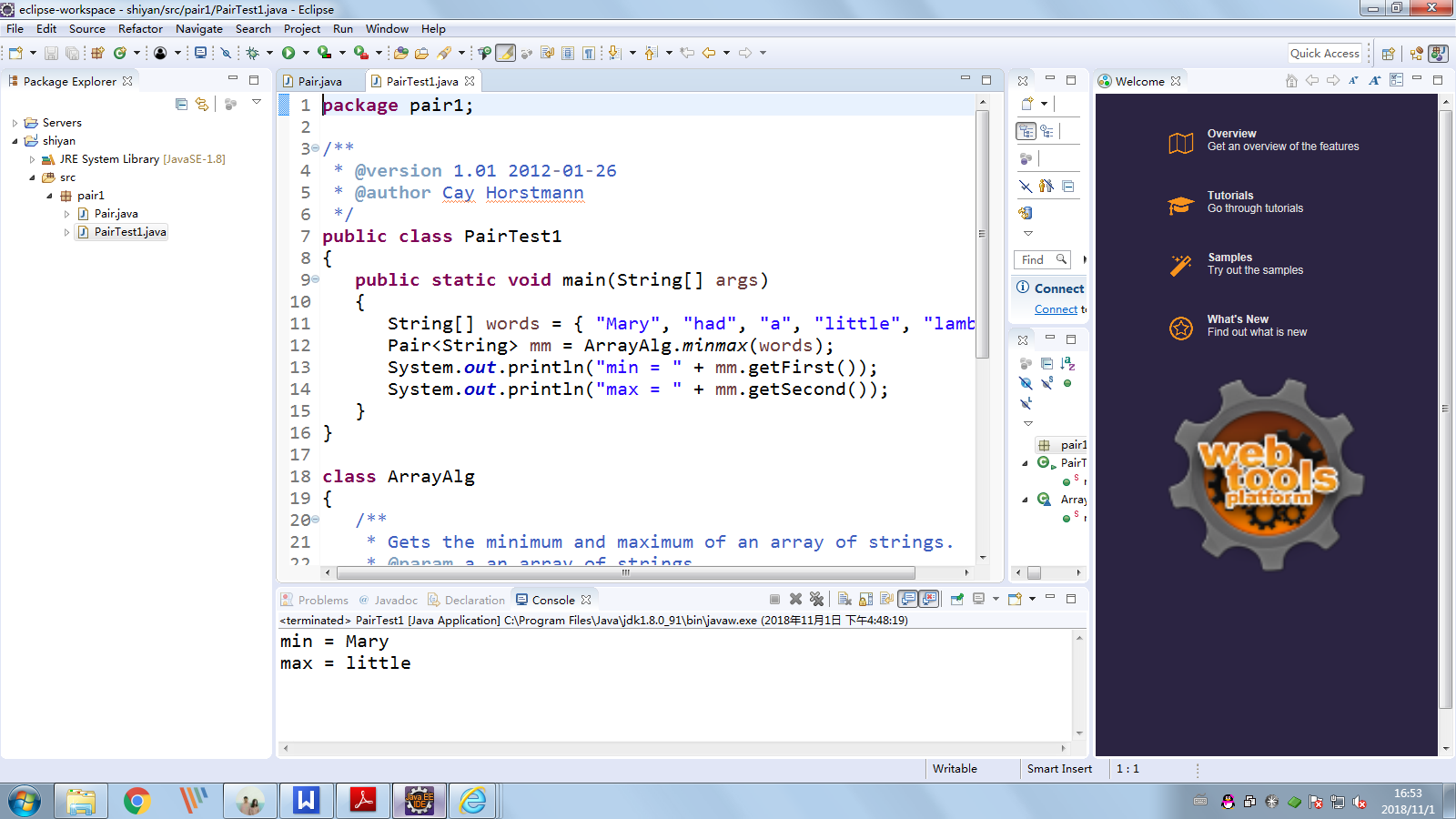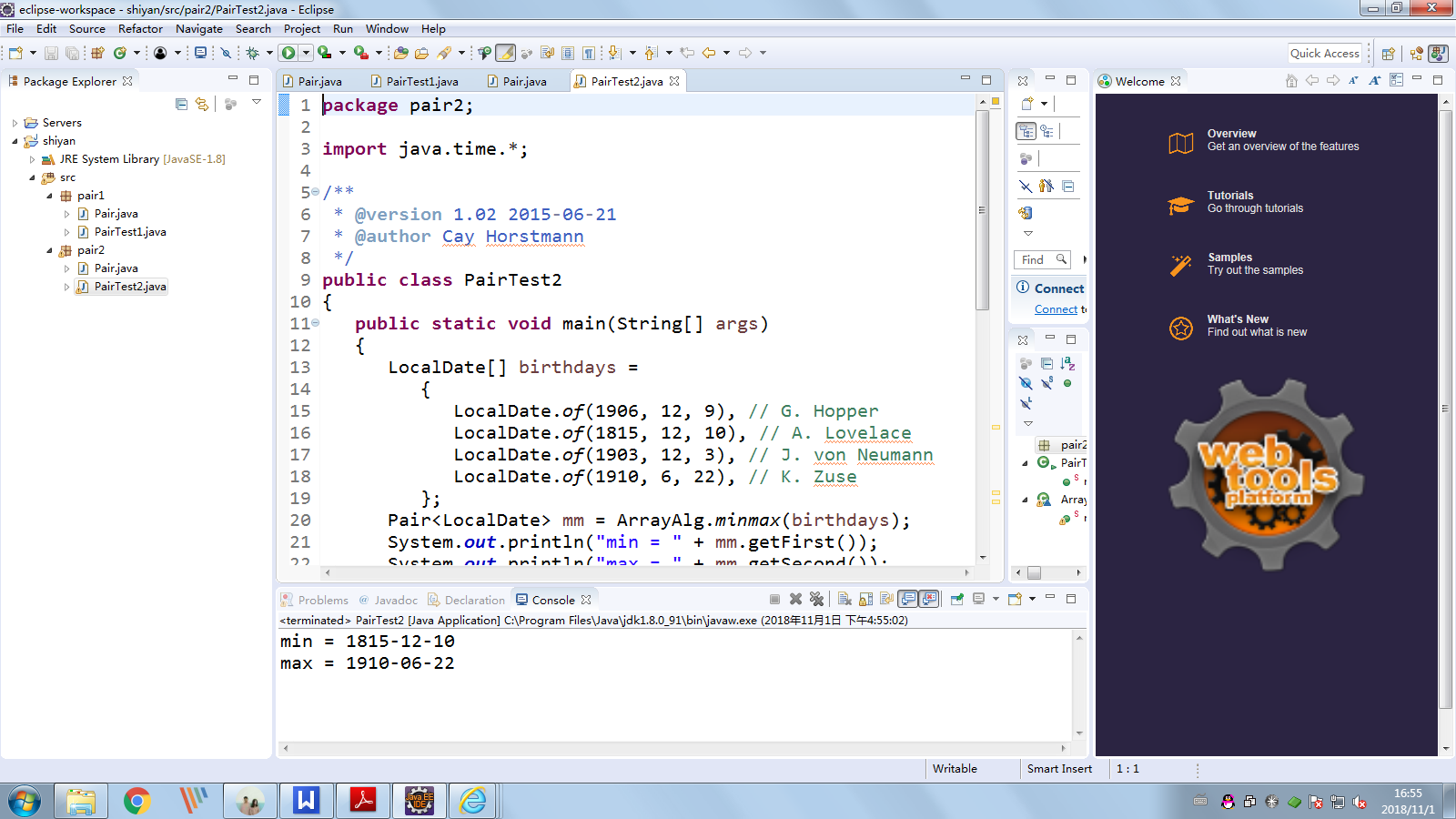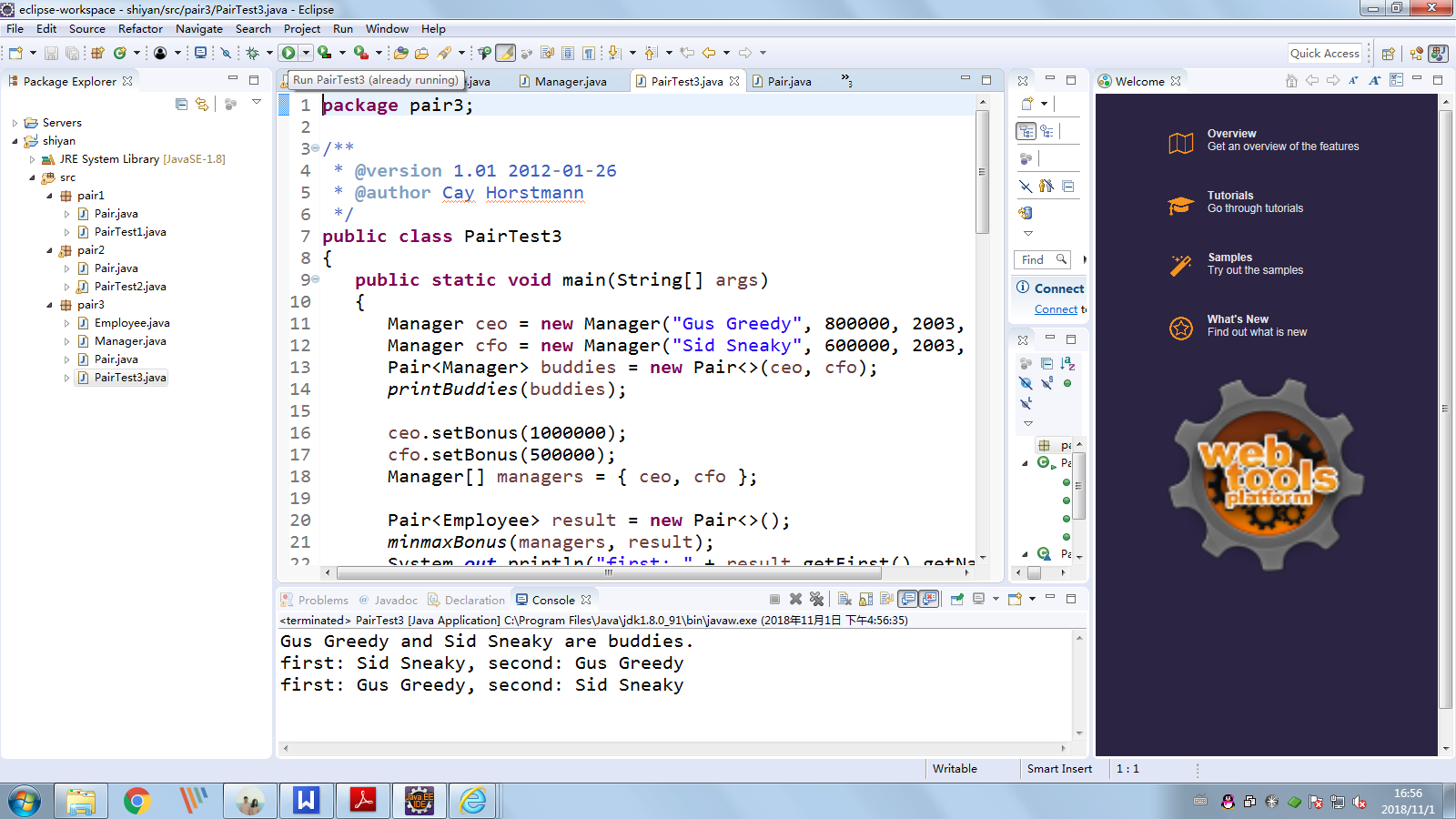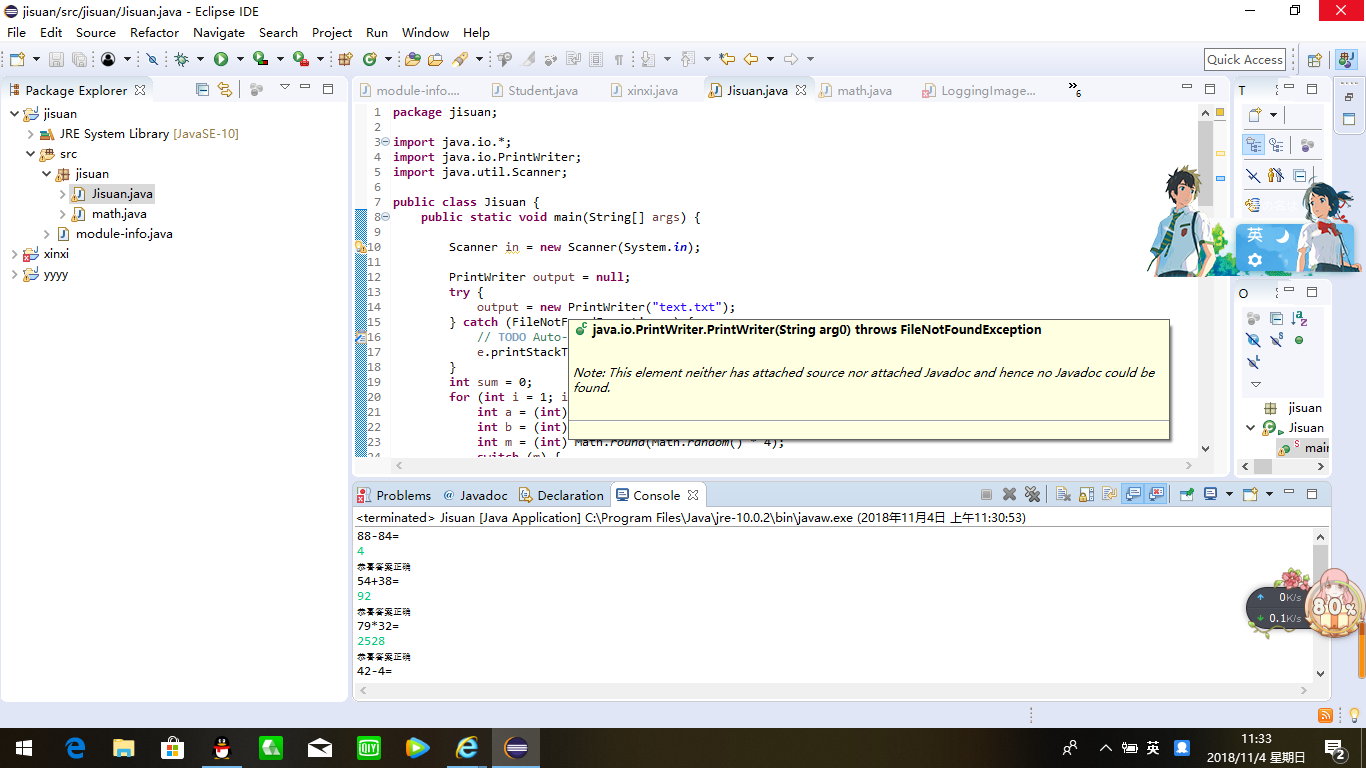实验十 泛型程序设计技术
实验时间 2018-11-1
基础知识:
1 什么是泛型程序设计?
. JDK 5.0 中增加的泛型类型,是Java 语言中类型安全的一次重要改进。
. 泛型:也称参数化类型(parameterized type),就是在定义类、接口和方法时,通过类型参数指示将要处理的对象类型。(如ArrayList类)
. 泛型程序设计(Generic programming):编写代码可以被很多不同类型的对象所重用。
2 泛型类的定义 :一个泛型类(generic class)就是具有一个或多个类型变量的类,即创建用类型作为参数的类。如一个泛型类定义格式如下:
class Generics<K,V>其中的K和V是类中的可变类型参数。
Pair类引入了一个类型变量T,用尖括号(<>)括起来,并放在类名的后面。泛型类可以有多个类型变量。例如:
public class Pair<T, U> { … }类定义中的类型变量用于指定方法的返回类型以及域、局部变量的类型。
3 泛型方法的声明: 除了泛型类外,还可以只单独定义一个方法作为泛型方法,用于指定方法参数或者返回值为泛型类型,留待方法调用时确定。
– 泛型方法可以声明在泛型类中,也可以声明在普通类中。
4 泛型变量的限定:public class NumberGeneric< T extends Number>泛型变量上界的说明,上述声明规定了NumberGeneric类所能处理的泛型变量类型需和Number有继承关系;extends关键字所声明的上界既可以是一个类,也可以是一个接口;
List<? super CashCard> cards = new ArrayList<T>();泛型变量下界的说明,通过使用super关键字可以固定泛型参数的类型为某种类型或者其超类, 当程序希望为一个方法的参数限定类型时,通常可以使用下限通配符。
5 泛型类的约束与局限性(*)
不能用基本类型实例化类型参数
运行时类型查询只适用于原始类型
不能抛出也不能捕获泛型类实例
参数化类型的数组不合法
不能实例化类型变量
泛型类的静态上下文中类型变量无效
注意擦除后的冲突
6 通配符类型通配符: “?”符号表明参数的类型可以是任何一种类型,它和参数T的含义是有区别的。T表示一种未知类型,而“?”表示任何一种类型。这种通配符一般有以下三种用法:
– 单独的?,用于表示任何类型。
– ? extends type,表示带有上界。
– ? super type,表示带有下界。
实验内容
1、实验目的与要求
(1) 理解泛型概念;
(2) 掌握泛型类的定义与使用;
(3) 掌握泛型方法的声明与使用;
(4) 掌握泛型接口的定义与实现;
(5)了解泛型程序设计,理解其用途。
2、实验内容和步骤
实验1: 导入第8章示例程序,测试程序并进行代码注释。
测试程序1:
l 编辑、调试、运行教材311、312页 代码,结合程序运行结果理解程序;
l 在泛型类定义及使用代码处添加注释;
l 掌握泛型类的定义及使用。


package pair1; /** * @version 1.00 2004-05-10 * @author Cay Horstmann */ //Pair泛型类 public class Pair<T> //Pair类引入了一个类型变量T { private T first; private T second; public Pair() { first = null; second = null; } public Pair(T first, T second) { this.first = first; this.second = second; } public T getFirst() { return first; } public T getSecond() { return second; } public void setFirst(T newValue) { first = newValue; } public void setSecond(T newValue) { second = newValue; } }

package pair1; /** * @version 1.01 2012-01-26 * @author Cay Horstmann */ public class PairTest1 { public static void main(String[] args) { String[] words = { "Mary", "had", "a", "little", "lamb" }; Pair<String> mm = ArrayAlg.minmax(words); System.out.println("min = " + mm.getFirst()); System.out.println("max = " + mm.getSecond()); } } class ArrayAlg { /** * Gets the minimum and maximum of an array of strings. * @param a an array of strings * @return a pair with the min and max value, or null if a is null or empty */ public static Pair<String> minmax(String[] a)//返回值为实例化的类对象 { if (a == null || a.length == 0) return null; String min = a[0]; String max = a[0]; for (int i = 1; i < a.length; i++) { if (min.compareTo(a[i]) > 0) min = a[i];//若比较结果大于0,则表明此时的min不是最小的,将新的字符串存进min if (max.compareTo(a[i]) < 0) max = a[i];//和上面min的 比较方法一样 } return new Pair<>(min, max);//返回新的Pair类对象 } }
测试程序2:
l 编辑、调试运行教材315页 PairTest2,结合程序运行结果理解程序;
l 在泛型程序设计代码处添加相关注释;
l 掌握泛型方法、泛型变量限定的定义及用途。


package pair1; /** * @version 1.00 2004-05-10 * @author Cay Horstmann */ //Pair泛型类 public class Pair<T> //Pair类引入了一个类型变量T { private T first; private T second; public Pair() { first = null; second = null; } public Pair(T first, T second) { this.first = first; this.second = second; } public T getFirst() { return first; } public T getSecond() { return second; } public void setFirst(T newValue) { first = newValue; } public void setSecond(T newValue) { second = newValue; } }
package pair2; import java.time.*; /** * @version 1.02 2015-06-21 * @author Cay Horstmann */ public class PairTest2 { public static void main(String[] args) { LocalDate[] birthdays = { LocalDate.of(1906, 12, 9), // G. Hopper LocalDate.of(1815, 12, 10), // A. Lovelace LocalDate.of(1903, 12, 3), // J. von Neumann LocalDate.of(1910, 6, 22), // K. Zuse }; Pair<LocalDate> mm = ArrayAlg.minmax(birthdays);//定义Pair类对象mm System.out.println("min = " + mm.getFirst()); System.out.println("max = " + mm.getSecond()); } } class ArrayAlg { /** Gets the minimum and maximum of an array of objects of type T. @param a an array of objects of type T @return a pair with the min and max value, or null if a is null or empty */ public static <T extends Comparable> Pair<T> minmax(T[] a) //将T限制为 实现了Comparable接口的类,则泛型的minmax方法只能被实现了Comparable接口的类的数组调用 { if (a == null || a.length == 0) return null; T min = a[0]; T max = a[0]; for (int i = 1; i < a.length; i++) { if (min.compareTo(a[i]) > 0) min = a[i];//若比较结果大于0,则表明此时的min不是最小的,将新的字符串存进min if (max.compareTo(a[i]) < 0) max = a[i];//和上面min的 比较方法一样 } return new Pair<>(min, max);//返回新的Pair类对象 } }
测试程序3:
l 用调试运行教材335页 PairTest3,结合程序运行结果理解程序;
l 了解通配符类型的定义及用途。


package pair3; import java.time.*; public class Employee { //属性 private String name; private double salary; private LocalDate hireDay; public Employee(String name, double salary, int year, int month, int day)//构造器 { this.name = name; this.salary = salary; hireDay = LocalDate.of(year, month, day); } //访问器 public String getName() { return name; } //访问器 public double getSalary() { return salary; } //访问器 public LocalDate getHireDay() { return hireDay; } //完成涨工资的计算 public void raiseSalary(double byPercent) { double raise = salary * byPercent / 100; salary += raise; } }

package pair3; public class Manager extends Employee//子类为manager,父类为emploee { private double bonus;//属性 /** @param name the employee's name @param salary the salary @param year the hire year @param month the hire month @param day the hire day */ //构造器 public Manager(String name, double salary, int year, int month, int day) { super(name, salary, year, month, day); bonus = 0; } //访问器 public double getSalary() { double baseSalary = super.getSalary(); return baseSalary + bonus; } //更改器 public void setBonus(double b) { bonus = b; } //访问器 public double getBonus() { return bonus; } }

package pair3; /** * @version 1.00 2004-05-10 * @author Cay Horstmann */ public class Pair<T> //Pair类引入了一个类型变量T { private T first; private T second; public Pair() { first = null; second = null; } public Pair(T first, T second) { this.first = first; this.second = second; } public T getFirst() { return first; } public T getSecond() { return second; } public void setFirst(T newValue) { first = newValue; } public void setSecond(T newValue) { second = newValue; } }

package pair3; /** * @version 1.01 2012-01-26 * @author Cay Horstmann */ public class PairTest3 { public static void main(String[] args) { Manager ceo = new Manager("Gus Greedy", 800000, 2003, 12, 15); Manager cfo = new Manager("Sid Sneaky", 600000, 2003, 12, 15); Pair<Manager> buddies = new Pair<>(ceo, cfo); printBuddies(buddies); ceo.setBonus(1000000); cfo.setBonus(500000); Manager[] managers = { ceo, cfo }; Pair<Employee> result = new Pair<>(); minmaxBonus(managers, result); System.out.println("first: " + result.getFirst().getName() + ", second: " + result.getSecond().getName()); maxminBonus(managers, result); System.out.println("first: " + result.getFirst().getName() + ", second: " + result.getSecond().getName()); } public static void printBuddies(Pair<? extends Employee> p)//?是通配符,表明参数的类型是上界为Employee的任何一种类型 { Employee first = p.getFirst(); Employee second = p.getSecond(); System.out.println(first.getName() + " and " + second.getName() + " are buddies."); } public static void minmaxBonus(Manager[] a, Pair<? super Manager> result)//?是通配符,表明参数的类型是下界为manager的任何一种类型 { if (a.length == 0) return; Manager min = a[0]; Manager max = a[0]; for (int i = 1; i < a.length; i++) { if (min.getBonus() > a[i].getBonus()) min = a[i]; if (max.getBonus() < a[i].getBonus()) max = a[i]; } result.setFirst(min); result.setSecond(max); } public static void maxminBonus(Manager[] a, Pair<? super Manager> result)//?是通配符,表明参数的类型是下界为manager的任何一种类型 { minmaxBonus(a, result); PairAlg.swapHelper(result); // OK--swapHelper captures wildcard type } // Can't write public static <T super manager> ... } class PairAlg { public static boolean hasNulls(Pair<?> p) { return p.getFirst() == null || p.getSecond() == null; } public static void swap(Pair<?> p) { swapHelper(p); } public static <T> void swapHelper(Pair<T> p) { T t = p.getFirst(); p.setFirst(p.getSecond()); p.setSecond(t); } }
实验2:编程练习:
编程练习1:实验九编程题总结
l 实验九编程练习1总结(从程序总体结构说明、模块说明,目前程序设计存在的困难与问题三个方面阐述)。
1.程序总体结构说明:
主类为xinxi,子类为Student
2.模块说明:
首先是文件的读入操作,然后利用switch语句对需要处理的几种情况进行了分别处理。

package xinxi; import java.io.BufferedReader; import java.io.File; import java.io.FileInputStream; import java.io.FileNotFoundException; import java.io.IOException; import java.io.InputStreamReader; import java.util.ArrayList; import java.util.Arrays; import java.util.Collections; import java.util.Scanner; public class xinxi{ private static ArrayList<Student> studentlist; public static void main(String[] args) { studentlist = new ArrayList<>(); @SuppressWarnings("resource") Scanner scanner = new Scanner(System.in); File file = new File("F:\\身份证号.txt"); try { FileInputStream fis = new FileInputStream(file); @SuppressWarnings("resource") BufferedReader in = new BufferedReader(new InputStreamReader(fis)); String temp = null; while ((temp = in.readLine()) != null) { @SuppressWarnings("resource") Scanner linescanner = new Scanner(temp); linescanner.useDelimiter(" "); String name = linescanner.next(); String number = linescanner.next(); String sex = linescanner.next(); String age = linescanner.next(); String province =linescanner.nextLine(); Student student = new Student(); student.setName(name); student.setnumber(number); student.setsex(sex); int a = Integer.parseInt(age); student.setage(a); student.setprovince(province); studentlist.add(student); } } catch (FileNotFoundException e) { System.out.println("学生信息文件找不到"); e.printStackTrace(); } catch (IOException e) { System.out.println("学生信息文件读取错误"); e.printStackTrace(); } boolean isTrue = true; while (isTrue) { System.out.println("输入序号进行相应的操作"); System.out.println("1.字典排序"); System.out.println("2.输出年龄最大和年龄最小的人"); System.out.println("3.查找与你年龄相近的人"); System.out.println("4.查找你的同乡"); String n = scanner.next(); switch (n) { case "1": Collections.sort(studentlist); System.out.println(studentlist.toString()); break; case "2": int max=0,min=100; int j,k1 = 0,k2=0; for(int i=1;i<studentlist.size();i++) { j=studentlist.get(i).getage(); if(j>max) { max=j; k1=i; } if(j<min) { min=j; k2=i; } } System.out.println("年龄最大:"+studentlist.get(k1)); System.out.println("年龄最小:"+studentlist.get(k2)); break; case "3": System.out.println("年龄:"); int yourage = scanner.nextInt(); int near=agenear(yourage); @SuppressWarnings("unused") int value=yourage-studentlist.get(near).getage(); System.out.println("和你年龄相近的是"+studentlist.get(near)); break; case "4": System.out.println("输入你的家乡"); String find = scanner.next(); String place=find.substring(0,3); for (int i = 0; i <studentlist.size(); i++) { if(studentlist.get(i).getprovince().substring(1,4).equals(place)) System.out.println("你的同乡是 "+studentlist.get(i)); } break; } } } public static int agenear(int age) { @SuppressWarnings("unused") int j=0,min=53,value=0,k=0; for (int i = 0; i < studentlist.size(); i++) { value=studentlist.get(i).getage()-age; if(value<0) value=-value; if (value<min) { min=value; k=i; } } return k; } }
这一部分要是对学生信息文件的具体处理。

package xinxi; public class Student implements Comparable<Student> { private String name; private String number ; private String sex ; private int age; private String province; public String getName() { return name; } public void setName(String name) { this.name = name; } public String getnumber() { return number; } public void setnumber(String number) { this.number = number; } public String getsex() { return sex ; } public void setsex(String sex ) { this.sex =sex ; } public int getage() { return age; } public void setage(int age) { this.age= age; } public String getprovince() { return province; } public void setprovince(String province) { this.province=province ; } public int compareTo(Student o) { return this.name.compareTo(o.getName()); } public String toString() { return name+"\t"+sex+"\t"+age+"\t"+number+"\t"+province+"\n"; } }
3.目前程序设计存在的困难与问题:在文件的读取方面存在一定的问题,此外数据处理方面的转换也有相应的问题。
l 实验九编程练习2总结(从程序总体结构说明、模块说明,目前程序设计存在的困难与问题三个方面阐述)。
1.程序总体结构说明
2.模块说明:
这一部分主要完成了随机生成数和利用switch语句对四则运算的基本操作

package jisuan; import java.util.Scanner; public class Jisuan { public static void main(String[] args) { Scanner in = new Scanner(System.in); int sum = 0; for (int i = 0; i < 10; i++) { int a = (int) Math.round(Math.random() * 100); int b = (int) Math.round(Math.random() * 100); int d = (int) Math.round(Math.random() * 3); switch (d) { case 0: if(b!=0) { System.out.println(a + "/" + b + "="); int c = in.nextInt(); if (c == a / b) { sum += 10; System.out.println("恭喜答案正确"); } else { System.out.println("抱歉,答案错误"); } }else { System.out.println("此表达式错误"); } break; case 1: System.out.println(a + "+" + b + "="); int c0 = in.nextInt(); if (c0 == a + b) { sum += 10; System.out.println("恭喜答案正确"); } else { System.out.println("抱歉,答案错误"); } break; case 2: System.out.println(a + "-" + b + "="); int c1 = in.nextInt(); if (c1 == a + b) { sum += 10; System.out.println("恭喜答案正确"); } else { System.out.println("抱歉,答案错误"); } break; case 3: System.out.println(a + "*" + b + "="); int c2 = in.nextInt(); if (c2 == a + b) { sum += 10; System.out.println("恭喜答案正确"); } else { System.out.println("抱歉,答案错误"); } break; } } System.out.println("你的得分为" + sum); } }
shuchu部分主要完成了将程序运算结果以txt文件输出

package jisuan; import java.io.FileNotFoundException; import java.io.FileOutputStream; import java.io.PrintWriter; import java.util.Scanner; public class shuchu { public static void main(String[] args) { Scanner in = new Scanner(System.in); Jisuan counter = new Jisuan(); PrintWriter out = null; try { out = new PrintWriter("shu.txt"); } catch (FileNotFoundException e) { // TODO Auto-generated catch block e.printStackTrace(); } } }
3.目前程序设计存在的困难与问题:将程序运算结果以txt文件输出方面存在问题。
编程练习2:采用泛型程序设计技术改进实验九编程练习2,使之可处理实数四则运算,其他要求不变。
代码如下:

package jisuan; import java.io.*; import java.io.PrintWriter; import java.util.Scanner; public class Jisuan { public static void main(String[] args) { Scanner in = new Scanner(System.in); PrintWriter output = null; try { output = new PrintWriter("text.txt"); } catch (FileNotFoundException e) { // TODO Auto-generated catch block e.printStackTrace(); } int sum = 0; for (int i = 1; i <= 10; i++) { int a = (int) Math.round(Math.random() * 100); int b = (int) Math.round(Math.random() * 100); int m = (int) Math.round(Math.random() * 4); switch (m) { case 1: while (b == 0) { b = (int) Math.round(Math.random() * 100); } while (a % b != 0) { a = (int) Math.round(Math.random() * 100); } System.out.println(a + "/" + b + "="); int c1 = in.nextInt(); output.println(a + "/" + b + "=" + c1); if (c1 == a / b) { System.out.println("恭喜答案正确"); sum += 10; } else { System.out.println("抱歉,答案错误"); } break; case 2: System.out.println( a + "*" + b + "="); int c2 = in.nextInt(); output.println(a + "*" + b + "=" + c2); if (c2 == a * b) { System.out.println("恭喜答案正确"); sum += 10; } else { System.out.println("抱歉,答案错误"); } break; case 3: System.out.println( a + "+" + b + "="); int c3 = in.nextInt(); output.println(a + "+" + b + "=" + c3); if (c3 == a + b) { System.out.println("恭喜答案正确"); sum += 10; } else { System.out.println("抱歉,答案错误"); } break; case 4: while (a < b) { a = (int) Math.round(Math.random() * 100); } System.out.println( a + "-" + b + "="); int c4 = in.nextInt(); output.println(a + "-" + b + "=" + c4); if (c4 == a - b) { System.out.println("恭喜答案正确"); sum += 10; } else { System.out.println("抱歉,答案错误"); } break; } } System.out.println("成绩" + sum); output.println("成绩" + sum); output.close(); } }

package jisuan; public class math<T> { private T a; private T b; public int add(int a, int b) { return a + b; } public int reduce(int a, int b) { return a - b; } public int multiplication(int a, int b) { return a * b; } public int division(int a, int b) { if (b != 0 && a % b == 0) return a / b; else return 0; } }
实验结果如下图



实验总结:理解掌握了泛型类的定义与使用,泛型方法的声明与使用;泛型接口的定义与实现;此外,对上次实验的总结反思方面,从中发现了自己的很多不足,尤其是四则运算的编程,相比上次实验,从中认识到了很多不足,通过改正,完善了上次没有将程序运行结果以txt文件输出的不足。而且通过这次对泛型类的学习,将其与四则运算的编程结合起来,使的四则运算的程序更加完整,可以实现各种数据类型的运算。有了很大的提升,让我意识到要不断对之前学过的内容进行反思总结,不断完善之前的不足,这样才有提升。





 浙公网安备 33010602011771号
浙公网安备 33010602011771号